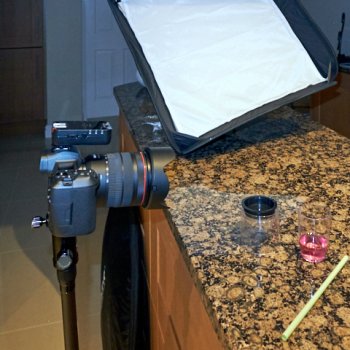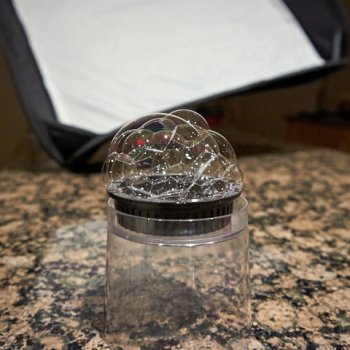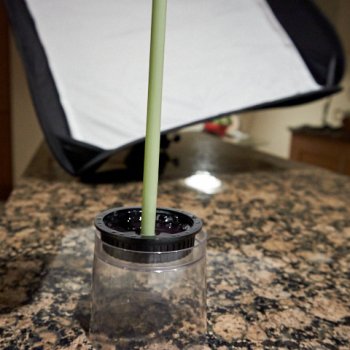How do you do soap film bubble macro? Linked in the How Do You Do It sticky thread.
1. First make up a bubble solution (pink here but colour is based on the soap you use and is irrelevant). All sorts of recipes available on the internet, many of which require glycerin which you may not have. The glycerin is there to increase the viscosity of the water film to help the bubble last longer but other water-soluble thickeners will work. Corn syrup is a good bet ( don't waste maple syrup). Two parts water, one part dish soap (washing-up liquid over here) and one quarter part syrup does the job. All you need are a few tablespoons of mixture and the ratios are not actually critical.
2. Hardware. Camera (obviously), a drinking straw, camera body cap or other shallow black dish. Flash (with soft box-type diffuser if you can as below). The bigger you make the source of light relative to the bubble, the better. Nice diffused light works best but a flash through a sheet of thin baking parchment will also work. Some way of triggering your flash off camera (cable or wireless/optical). Continuous light should also work but you need enough to get a high shutter speed.

As with all close-up work, a macro lens will work but will be more difficult to focus at higher magnifications. Especially true when the bubble only lasts for a matter of seconds and wobbles! Perhaps easier using a longer lens at its closest focussing distance. In this case I used a 24-105mm at about 12-inches from the subject.
3. Put the bubble mixture in the black dish and blow some bubbles using the straw. Takes a bit of practice but you will soon get the hang of blowing single large bubbles that last long enough to photograph.

an early trial...
4. Set up your lens focus using manual focus. Placing the straw in the dish gives something to focus on.

5. Set your camera to Manual mode and set a reasonably narrow aperture to give the best chance of focus. Say f11. Set shutter speed to the around the maximum flash sync speed (if you don't know then guess 1/150th sec). Take a photo with the flash switched off- should be essentially black. If you have a stand for your flash, set it with the flash as close as possible to the dish but still allowing you access to blow the bubble with the straw.
6. Turn flash on and blow your bubble. While the bubble is still inflated, take shots as quickly as your flash recycle permits. If you have to hand-hold your flash, make sure you move smoothly to avoid air currents that will disturb and burst the bubble before you get a chance to take a shot. Repeat often!
7. Import photos into your preferred editing software. Not much post-processing required. I tend to darken the blacks and add a little boost to the brightness - in effect increasing the contrast a bit. You will almost certainly have to crop quite tightly to get the required detail to fill the frame. These shots are about 10-25%% or so of the full frame but your lens will dictate how big the image you can get.

Original out-of-camera image.

The Blue Planet
1. First make up a bubble solution (pink here but colour is based on the soap you use and is irrelevant). All sorts of recipes available on the internet, many of which require glycerin which you may not have. The glycerin is there to increase the viscosity of the water film to help the bubble last longer but other water-soluble thickeners will work. Corn syrup is a good bet ( don't waste maple syrup). Two parts water, one part dish soap (washing-up liquid over here) and one quarter part syrup does the job. All you need are a few tablespoons of mixture and the ratios are not actually critical.
2. Hardware. Camera (obviously), a drinking straw, camera body cap or other shallow black dish. Flash (with soft box-type diffuser if you can as below). The bigger you make the source of light relative to the bubble, the better. Nice diffused light works best but a flash through a sheet of thin baking parchment will also work. Some way of triggering your flash off camera (cable or wireless/optical). Continuous light should also work but you need enough to get a high shutter speed.

As with all close-up work, a macro lens will work but will be more difficult to focus at higher magnifications. Especially true when the bubble only lasts for a matter of seconds and wobbles! Perhaps easier using a longer lens at its closest focussing distance. In this case I used a 24-105mm at about 12-inches from the subject.
3. Put the bubble mixture in the black dish and blow some bubbles using the straw. Takes a bit of practice but you will soon get the hang of blowing single large bubbles that last long enough to photograph.

an early trial...
4. Set up your lens focus using manual focus. Placing the straw in the dish gives something to focus on.

5. Set your camera to Manual mode and set a reasonably narrow aperture to give the best chance of focus. Say f11. Set shutter speed to the around the maximum flash sync speed (if you don't know then guess 1/150th sec). Take a photo with the flash switched off- should be essentially black. If you have a stand for your flash, set it with the flash as close as possible to the dish but still allowing you access to blow the bubble with the straw.
6. Turn flash on and blow your bubble. While the bubble is still inflated, take shots as quickly as your flash recycle permits. If you have to hand-hold your flash, make sure you move smoothly to avoid air currents that will disturb and burst the bubble before you get a chance to take a shot. Repeat often!
7. Import photos into your preferred editing software. Not much post-processing required. I tend to darken the blacks and add a little boost to the brightness - in effect increasing the contrast a bit. You will almost certainly have to crop quite tightly to get the required detail to fill the frame. These shots are about 10-25%% or so of the full frame but your lens will dictate how big the image you can get.

Original out-of-camera image.

The Blue Planet
Last edited:


 Tadpole journey
Tadpole journey